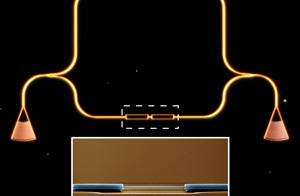C reative
Particle
Higgs
CPH Theory is based on Generalized light velocity from energy into mass.
CPH Theory in Journals
|
Photons drive nanomachines
|
|
Photonic circuit in which optical force is harnessed to drive nanomechanics. (c) H. Tang, Yale University Science fiction writers have long envisioned sailing a spacecraft by the optical force of the sun's light. But, the forces of sunlight are too weak to fill even the oversized sails that have been tried. Now a team led by researchers at the Yale School of Engineering and Applied Science has shown that the force of light indeed can be harnessed to drive machines - when the process is scaled to nano-proportions. Their work opens the door to a new class of semiconductor devices that are operated by the force of light. They envision a future where this process powers quantum information processing and sensing devices, as well as telecommunications that run at ultra-high speed and consume little power. The research, appearing in the 27 November issue of Nature, demonstrates a marriage of two emerging fields of research - nanophotonics and nanomechanics. - which makes possible the extreme miniaturisation of optics and mechanics on a silicon chip. The energy of light has been harnessed and used in many ways. The 'force' of light is different - it is a push or a pull action that causes something to move. 'While the force of light is far too weak for us to feel in everyday life, we have found that it can be harnessed and used at the nanoscale,' said team leader Hong Tang, assistant professor at Yale. 'Our work demonstrates the advantage of using nano-objects as 'targets' for the force of light - using devices that are a billion-billion times smaller than a space sail, and that match the size of today's typical transistors.' Until now light has only been used to manoeuvre single tiny objects with a focused laser beam - a technique called 'optical tweezers.' Postdoctoral scientist and lead author, Mo Li noted, 'Instead of moving particles with light, now we integrate everything on a chip and move a semiconductor device.' 'When researchers talk about optical forces, they are generally referring to the radiation pressure light applies in the direction of the flow of light,' said Tang. 'The new force we have investigated actually kicks out to the side of that light flow.' While this new optical force was predicted by several theories, the proof required state-of-the-art nanophotonics to confine light with ultra-high intensity within nanoscale photonic wires. The researchers showed that when the concentrated light was guided through a nanoscale mechanical device, significant light force could be generated - enough, in fact, to operate nanoscale machinery on a silicon chip. The light force was routed in much the same way electronic wires are laid out on today's large scale integrated circuits. Because light intensity is much higher when it is guided at the nanoscale, they were able to exploit the force. 'We calculate that the illumination we harness is a million times stronger than direct sunlight,' adds Wolfram Pernice, a Humboldt postdoctoral fellow with Tang. 'We create hundreds of devices on a single chip, and all of them work,' says Tang, who attributes this success to a great optical I/O device design provided by their collaborators at the University of Washington. It took more than 60 years to progress from the first transistors to the speed and power of today's computers. Creating devices that run solely on light rather than electronics will now begin a similar process of development, according to the authors. 'While this development has brought us a new device concept and a giant step forward in speed, the next developments will be in improving the mechanical aspects of the system. But,' says Tang, 'the photon force is with us.'
Tang's team at Yale also included graduate student Chi Xiong.
Collaborators at University of Washington were T. Baehr-Jones
and M. Hochberg. Funding in support of the project came from the
National Science Foundation, the Air Force Office of Scientific
Research and the Alexander von Humboldt post-doctoral fellowship
program. Source: http://www.sciencecentric.com/news/article.php?q=08112701-photons-drive-nanomachines
1 2 3 4 5 6 7 8 9 10 Newest articles
|
|
Sub quantum space and interactions from photon to fermions and bosons |
Interesting articles
Since 1962 I doubted on Newton's laws. I did not accept the infinitive speed and I found un-vivid the laws of gravity and time.
I learned the Einstein's Relativity, thus I found some answers for my questions. But, I had another doubt of Infinitive Mass-Energy. And I wanted to know why light has stable speed?

